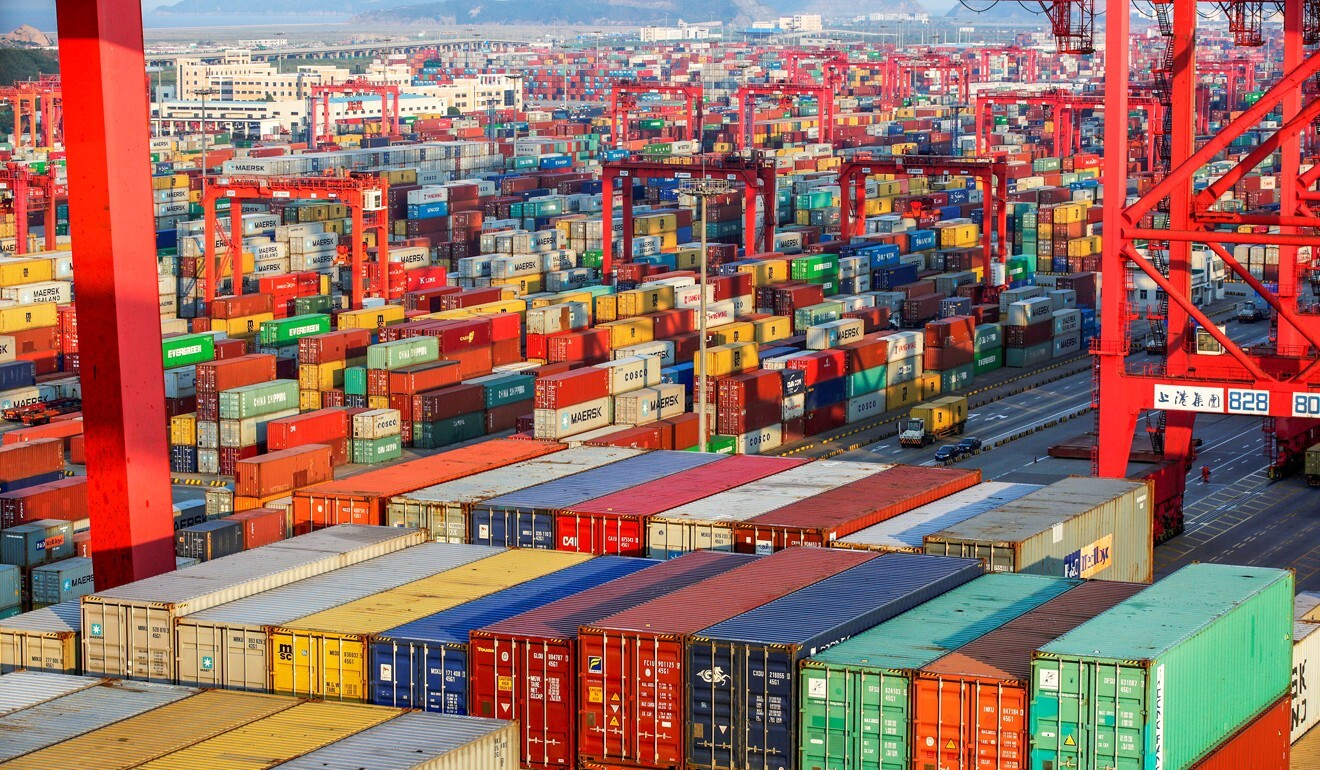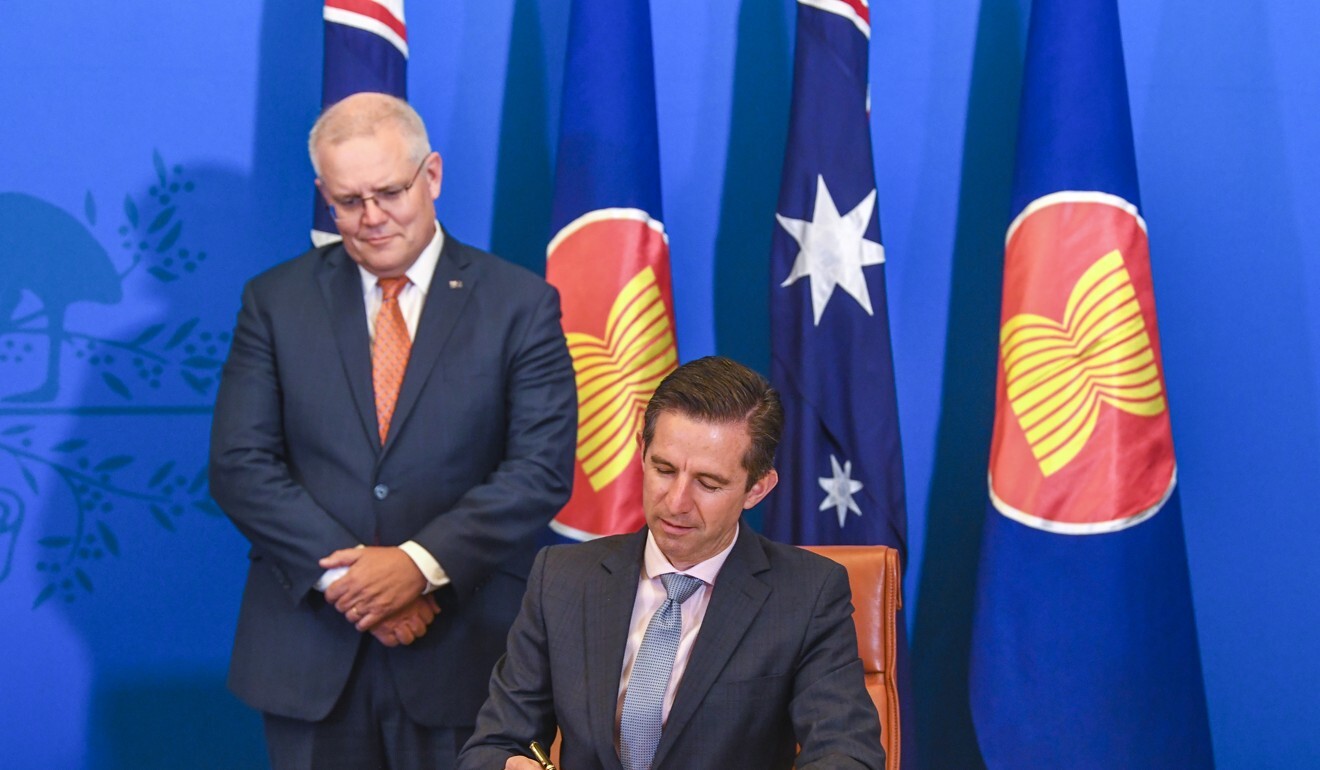
The RCEP has been signed, at last – but resistance to China could yet prove a hurdle before it takes effect
- Opposition to the deal could still come from participants’ parliaments, with analysts pointing to Australia, South Korea and Japan’s shaky relationships with Beijing
- Malaysia and Thailand are also seen as possibly delaying ratification – and even sans hurdles, the deal’s mostly likely start date could be January 1, 2022
Explained: the difference between the RCEP and the CPTPP
And even if there were no hurdles, the most likely start date for the deal would be January 1, 2022, rather than sometime next year, the observers said. Subsequently, with extensive so-called flexibility provisions on implementation timelines baked into the RCEP, participants may only feel its full effect years from now.

POTENTIAL BANANA SKINS
While there has been a chorus of elation among free-trade proponents over the RCEP’s long-awaited signing, Nick Marro of The Economist Intelligence Unit (EIU) told This Week in Asia that on the subject of ratification he was also looking at how the deal “fits into wider regional diplomatic and economic dynamics”.
For Asean, which primarily negotiated as a bloc, the appetite for trade liberalisation might be stronger, Marro said, citing the way Vietnam “embraced trade liberalisation as part of its economic development plans”.
Ratification by the likes of communist Vietnam and Laos as well as Brunei, an absolute monarchy, will be straightforward. In Singapore, where the ruling People‘s Action Party retains a decades-old parliamentary supermajority, trade and industry minister Chan Chun Sing said the deal would be ratified “very soon, in the next few months”.
Asia-Pacific nations prepare to sign world’s biggest free-trade deal at virtual summit
But even so, the story within the association was uneven, the analyst said, pointing to Malaysia’s delay in ratifying the CPTPP despite the administration of the day having signed the deal in March 2018.
There have been two turnovers of government since then, amid a fierce power struggle that dates back to the country’s May 2018 general election.
Thailand, ruled by the military-backed government of Prime Minister Prayuth Chan-ocha, had previously flirted with the idea of joining the CPTPP but enthusiasm has since faded.
“Malaysia still has not ratified the CPTPP, while Thailand has wobbled on whether to join that agreement,” Marro said. “That hesitation could risk spilling into the RCEP as well.” Nonetheless, these are worst-case scenarios.

In Malaysia’s case, opposition lawmaker Charles Santiago said ratification was a “done deal” since the country’s constitution did not mandate parliamentary assent for trade deals.
Still, he voiced concerns about the “secrecy” under which the deal was negotiated and the impact that enhanced market access to more industrialised economies would have on Malaysia’s small and medium-sized enterprises.
Deborah Elms, a Singapore-based trade consultant, said she currently did not see “particular challenges” in ratifying the RCEP, but said “complex internal procedures” in some countries could mean the deal came into effect later for these economies.
“Hence, a country like Australia often struggles to ratify any trade deal quickly,” said Elms, founder and executive director of the Asian Trade Centre consultancy. “They have to be given a specific impact analysis, run through special committees, read in parliament multiple times and so forth. It takes time. Most of the rest are much less complicated.”
She said it was “possible to imagine” that the required threshold of six Asean nations and three out of five of the external powers – deemed, in Asean parlance, as Dialogue Partners – would complete the ratification process next year.
“The agreement becomes active 60 days after the last qualifying member notifies the Asean Secretariat, so to hit a January deadline, it would mean members have to be ready by November 1, 2021,” Elms said.
Peter Mumford, the Southeast Asia practice head for the Eurasia Group political consultancy, concurred. He said while there “may be challenges in ratifying and implementing the pact in some countries … a sufficient number of members will do so, ensuring it enters into force”. He cited “later in 2021” as an optimistic timeline for the RCEP to come into force.
Pasha L. Hsieh, a Singapore Management University law professor who focuses on trade issues, said the deal’s flexible implementation timeline meant a long process lay ahead and “we should see the pact as the foundation for future talks”.

‘IMMENSE SYMBOLISM’
Elsewhere, the parsing of the deal’s written text – released for the first time on Sunday – spurred a range of commentary on its impact.
By and large, the trade commentariat has welcomed the RCEP, which was reached after eight years of talks stretching back to the first negotiation round in November 2012, a year after the plan for the deal was first introduced by Asean.
The bloc had hoped to finalise the deal last year, but that plan was scuttled as India – having taken part in 28 of the 31 rounds of talks – decided it would stay out of the RCEP over concerns accession would hurt various domestic sectors. New Delhi has been granted the right to re-enter the agreement at any time, subject to negotiations.
In its current form, the deal irons out differences in the terms between separate deals Asean has with the five participating outside powers: China, Australia, New Zealand, South Korea and Japan.
Experts acknowledge that the pact is somewhat of a low-lying fruit as far as free-trade agreements go, given how it does not significantly address rules for the e-commerce sector or environmental protection.
Nor does it stipulate any mechanism for disputes between foreign firms and states, or what is otherwise known in trade parlance as investor-state dispute settlement (ISDS).
India’s ‘door still open’ to RCEP free-trade deal: Foreign Minister Subrahmanyam Jaishankar
Still, the RCEP has been touted by Beijing and other governments as having immense symbolic ramifications amid the economic travails of the Covid-19 pandemic and the anti-free trade mood in the West.
Estimates by Michael Plummer, a professor of international economics at Johns Hopkins University in Bologna, and Peter Petri, a professor of international finance at Boston’s Brandeis University, showed that the deal would add US$186 billion to the world economy and 0.2 per cent to participant countries’ GDP.
Plummer told This Week in Asia that Japan, South Korea and China stood to gain the most, taking about 90 per cent of the income gains that would accrue to the RCEP economies, and 88 per cent of trade.
Also being eyed are possible new entrants to the pact after it comes into effect. Hong Kong’s government has publicly stated its intent to join the RCEP after the agreement was signed. Under the terms of the pact, it can only do so 18 months after the deal comes into effect.
“As Hong Kong already has free-trade agreements with Asean, China, Australia and New Zealand, the RCEP offers greater market access for Japan, Korea, and hopefully India one day,” said US-based trade lawyer Edmund Sim, a partner with investment law firm Appleton Luff. “With China getting some access to Japan and Korea via the RCEP, Hong Kong will need to make a decision soon on [the pact] or risk becoming less relevant in northeast Asia.”

